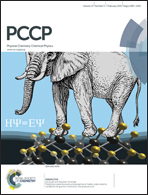Behind the color switching in gasochromic VO2†
Abstract
Gasochromic VO2 thin films were fabricated by the sol–gel spin-coating technique. The results of X-ray absorption spectroscopy and resonant inelastic X-ray scattering spectroscopy reveal that the origin of gasochromic coloration in VO2 is strongly related to the modulation of its structure and the electron–electron correlation. Upon gasochromic coloration, not only does the valence state change with the incorporation of hydrogen, but also the film undergoes the modification of the local atomic structure. The structural distortion varies the strength of hybridization of the O 2p–V 3d states and the bond distance of V–O and V–O varies. In the hydric process, the local atomic structure of VO2 changes from that of an un-symmetric to that of a symmetric V–O framework. The incorporated hydrogen adds electrons into the V 3d t2g orbital, enhancing the electron–electron correlation by reducing the V–V distance. This work presents a new physical insight in which the modulation of the electron–electron correlation is exploited to control the bleached and colored states, giving rise to the gasochromic phenomenon. The strong correlation among atomic spatial rearrangement, electronic structures, and transmittance supports a cooperative mechanism of the VO2 gasochromic transition. These results reveal a clear correlation between the dynamics of the lattice structure and the electronic properties and suggest a possible pathway to gasochromism and elucidation of its mechanism.


 Please wait while we load your content...
Please wait while we load your content...